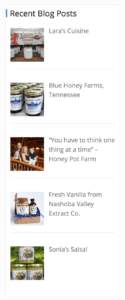DLSH.com – Bringing Deliciousness To Your Doorstep!

 DLSH.com is a startup online marketplace that connects yummy farmers and food crafters with hungry food loving consumers from all across the country [1]. DLSH offers foodie fans the opportunity to purchase a variety of food products from different geographical regions at all time throughout the year. For farmers and food crafters, DLSH provides a secure platform to share their stories and supplement their current physical sales, extending their geographic exposure and customer audience. Physical market vendors are often constrained by the traditional farmers’ market season. For example, the popular South of Washington (SoWa) Open Market in Boston, Massachusetts, occurs on Sunday afternoons from the first of May to the end of October [2]. For strictly fresh produce growers, this seasonality makes good sense and works just fine. According to the USDA, “144,530 farmers sold $1.3 billion” in fresh produce directly to consumers through farmers’ markets, roadside stands, u-pick operations, and community supported agriculture (CSA) arrangements in 2012. However, the seasonal timeline limits farmers and food crafters that specialize in less perishable items such as jarred, pickled, and canned fruits and vegetables. Furthermore, DLSH helps vendors who concentrate in nuts, honey, jerky, coffee, teas, spices, and other less seasonal products to extend their formerly limited selling period beyond the warm months. If regular market visitors are busy one Sunday afternoon, they can now have the opportunity to engage with their favorite physical market vendors on DLSH. Furthermore, after October, the temperature can get quite cold outside for the consumers! Thanks to DLSH, foodie fans can now purchase their local and regional goodies from the warm of their cozy couches.
DLSH.com is a startup online marketplace that connects yummy farmers and food crafters with hungry food loving consumers from all across the country [1]. DLSH offers foodie fans the opportunity to purchase a variety of food products from different geographical regions at all time throughout the year. For farmers and food crafters, DLSH provides a secure platform to share their stories and supplement their current physical sales, extending their geographic exposure and customer audience. Physical market vendors are often constrained by the traditional farmers’ market season. For example, the popular South of Washington (SoWa) Open Market in Boston, Massachusetts, occurs on Sunday afternoons from the first of May to the end of October [2]. For strictly fresh produce growers, this seasonality makes good sense and works just fine. According to the USDA, “144,530 farmers sold $1.3 billion” in fresh produce directly to consumers through farmers’ markets, roadside stands, u-pick operations, and community supported agriculture (CSA) arrangements in 2012. However, the seasonal timeline limits farmers and food crafters that specialize in less perishable items such as jarred, pickled, and canned fruits and vegetables. Furthermore, DLSH helps vendors who concentrate in nuts, honey, jerky, coffee, teas, spices, and other less seasonal products to extend their formerly limited selling period beyond the warm months. If regular market visitors are busy one Sunday afternoon, they can now have the opportunity to engage with their favorite physical market vendors on DLSH. Furthermore, after October, the temperature can get quite cold outside for the consumers! Thanks to DLSH, foodie fans can now purchase their local and regional goodies from the warm of their cozy couches.
Vendor Value
 DLSH designed its platform according to the theme of a farmers market (of course). Vendors setup their own DLSH digital booths (see right) to house their products, store details, photos, and contact information. These booths have unique web addresses that vendors can share with their physical market customers and networks. Also, vendors can describe their background in “About Us” section, and they also have an option to post updates or share their upcoming physical market locations in the “Booth News” bar, increasing potential touch points among network participants. For example, Lara’s Cuisine (a New England vendor) uses the “About Us” section to detail its founder’s journey from growing up in Italy to cooking and selling authentic Italian pesto in Massachusetts [4].
DLSH designed its platform according to the theme of a farmers market (of course). Vendors setup their own DLSH digital booths (see right) to house their products, store details, photos, and contact information. These booths have unique web addresses that vendors can share with their physical market customers and networks. Also, vendors can describe their background in “About Us” section, and they also have an option to post updates or share their upcoming physical market locations in the “Booth News” bar, increasing potential touch points among network participants. For example, Lara’s Cuisine (a New England vendor) uses the “About Us” section to detail its founder’s journey from growing up in Italy to cooking and selling authentic Italian pesto in Massachusetts [4].
 The DLSH homepage highlights new, bestselling, and featured products [5]. For vendors without e-commerce websites, DLSH provides a secure transaction platform for them to market and sell their goods online. For vendors with existing websites, DLSH can provide supplemental income and increased consumer exposure from its trafficked marketplace for growing sales and sharing stories. These small businesses do not often receive press or publicity.Thus, DLSH representatives travel the country in search of high quality and delicious farmers and food crafters to interview for its vendor blog, where DLSH highlights personal stories, entrepreneurial journeys, and small business insights. This content development benefits both sides of the market. The vendors are proud to share their articles with friends, families, and customers, and DLSH benefits from the increased traffic and time spent on the platform. Additionally, consumers have the opportunity to learn about and engage with the farmers through social media links and vendor contact information.
The DLSH homepage highlights new, bestselling, and featured products [5]. For vendors without e-commerce websites, DLSH provides a secure transaction platform for them to market and sell their goods online. For vendors with existing websites, DLSH can provide supplemental income and increased consumer exposure from its trafficked marketplace for growing sales and sharing stories. These small businesses do not often receive press or publicity.Thus, DLSH representatives travel the country in search of high quality and delicious farmers and food crafters to interview for its vendor blog, where DLSH highlights personal stories, entrepreneurial journeys, and small business insights. This content development benefits both sides of the market. The vendors are proud to share their articles with friends, families, and customers, and DLSH benefits from the increased traffic and time spent on the platform. Additionally, consumers have the opportunity to learn about and engage with the farmers through social media links and vendor contact information.
Next Steps
Can DLSH grow at a sustainable rate to satisfy both sides of the marketplace? Too many vendors and not enough consumers can discourage vendors. Also, an imbalance of consumers to vendors could cause consumers to lose interest in the platform due to variety frustrations. As it scales up, DLSH must ensure that it continues to recruit high quality vendors in both taste and food safety. Poor quality products may literally put a bad taste in consumers’ mouths and damage the platform’s reputation.
To increase user stickiness and knowledge exchange, DLSH should expand on its “Food Forum” initiative, designed for vendors and consumers to share recipes, physical market vendor tips, cottage laws, regulatory information, and other experiential tips [6]. Building on this resource can help DLSH deepen the platform’s community engagement, and increased user generated content can keep DLSH as a relevant resource while boosting the platform’s network effect. Lastly, DLSH can grow its network from mutually beneficial social media relationships with vendors marketing their booths and DLSH promoting vendors’ profiles across its network of foodie fans and followers.
words: 725
 [1] https://www.dlsh.com/about/
[1] https://www.dlsh.com/about/
[2] http://www.sowaboston.com/sowa-open-market/
[3] https://www.agcensus.usda.gov/Publications/2012/Online_Resources/Highlights/Farmers_Marketing/Highlights_Farmers_Marketing.pdf
[4] https://www.dlsh.com/store/laras-cuisine/
[5] https://www.dlsh.com/
[6] https://www.dlsh.com/food-forum/



First off, I need to request that Luke’s homemade buttermilk dressing and home-baked croutons be made for sale on DLSH.com. They are unreal.
This is quite an interesting business, because DLSH is not just a marketplace, but also a journalism/media outlet/marketing company of sorts. Given that many of these vendors have very little marketing in-person appearances and some social media presence, the fact that DLSH sources and promotes talent is a large value-add service for customers who appreciate good taste and a good story! I can imagine a scaled-up DLSH eventually serving as a kind of food-reporting service for towns across America. For instance, when I plan my vacation to Ames, Iowa, I could look up some of the best vendors in the county and incorporate them into my itinerary. For someone who loves food and farmers, it would be a new kind of foodie-cation.
I also think it’s an excellent operational choice for DLSH to not take on any of the logistics. However, given that much of the customer service and vendor margin may depend on the sophistication of the logistics, perhaps DLSH could offer best practices or recommendations to member vendors. Eventually, as volumes of vendors build in certain regions, DLSH could even help negotiate group rates with logistics providers.
I simply love this concept, thanks for sharing! When I was working downtown in Houston, I visited a farmer’s market every Wednesday for lunch – what I would do to order some jars of goodness from a few of those shops right now…
I do, however, fear for the sustainability and viability of this business model. Given the increasing popularity of doorstep delivery in almost every facet of life, including trendy grocery stores that favor gluten-free, organic, you-name-it high end products very similar to those that you would find at a farmer’s market, this website may certainly lose out. For example, InstaCart can deliver from Whole Foods or Trader Joe’s in as little as an hour. As cited in the article below, even Amazon is jumping on the grocery delivery train, and these platforms often offer same-day delivery on a much wider swath of products than offered by DLSH.
That being said, if DLSH can match supply and demand in a way that people who really love their farmer’s market products are utilizing the platform (and if they can achieve sizeable scale!), this could really be a home run, and a significantly positive change in the way these markets operate.
http://www.wsj.com/articles/amazon-to-expand-grocery-business-with-new-convenience-stores-1476189657
I like the idea and motivation for the company. I’ve actually met the founders of this company – great folks.
I would be interested to learn more about the regulations around selling perishable items online. I know grocery stores and amazon are able to do this easily but how do the rules change (if at all) for a small company? If I am some guy in Ohio that cooks and cans my tomatoes, do I need to do any testing before I can sell these canned tomatoes? How do the regulations change if I sell within my county or state to outside?
The benefit to DLSH is that they are just the middle man connecting the local farmers markets with the masses so any regulation is most likely on the producers of the product and not DLSH. But if new rules were implemented or existing ones enforced that made it more difficult to produce and ship homegrown products, that would negatively affect DLSH.
One thing I would like to see is a requests section where people can post what they are looking for. This might go into the forum section described in the post or could be another part of the site. Here, consumers could say something like “I’m looking for a red pepper and green olive tapenade”. Vendors can then see the requests and provide links to products they already have or can say “I can make that. I’ll send it to you next week.”
I love the idea of this marketplace – thanks so much for sharing! I’m a big fan of farmers’ markets and love the concept of helping create an online marketplace for their products and extend their selling season beyond the spring/summer months.
To Kimberly’s point above, I think the locally-sourced/small farmer aspect of the products needs to be highlighted for the product to feel different than what consumers could alternatively buy from Amazon/Whole Foods/etc. It feels like this is a marketplace that consumers will be driven to because they loved a product they tried at a physical market and want to get more of it, which hopefully will lead to more browsing on the DLSH marketplace and subsequent purchases of other products. It seems key to get the consumer hooked at the in-person point of purchase – having a physical presence at local farmers’ markets will be a good way to initially catch the consumer. I wonder if advertising could be expanded to other places that use farmers’ market products but don’t sell them per se – e.g., farm-to-table restaurants that use products sold by vendors on the platform could also be places to build awareness of and advocacy for the marketplace.
Thanks for sharing, Chris! I’ve been fascinated by this idea since we had a discussion a few days ago. I did some research on companies in this space and found that a few startups have either failed or had to pivot because they were unable to solve the logistics problem. For example, Farmigo raised $26mn but failed to scale their business because they took on the responsibility for shipping and were unable to deliver on their promise of next-day or 2-day shipping [1]. In that light, I believe DLSH made a wise decision to keep the shipping responsibility with producers.
Looking ahead, the biggest challenge I see for DLSH is top-of-funnel growth. Producers and farmers will receive value from DLSH only when there are lots of users on the platform. Would it be enough to invest in SEO, SEM, social media ads, etc. to get the word out there? Besides online marketing, I believe it’ll be beneficial to leverage existing relationships with farmers/producers on the website. This would entail each farmer/producer distributing information about DLSH to customers at farmers markets. While farmers markets are great for acquisition, DLSH could step in and help with customer retention by incentivizing repeat purchases. DLSH could also start a promo code for referrals to start a viral loop amongst its existing customer base. Finally, in terms of engagement and first-time purchase, it might help to provide the ability to purchase samples of several products from a farmer/producer. Given that these products have little-to-no brand recognition, customers may not be willing to spend $8-10 per item on DLSH. To help overcome this barrier, farmers/producers could sell a basket of samples from their collection – similar to what Kiehls does with their starter kits.
[1] Gould, D. (2016, July 22). Why Farmigo is shutting down its online farmers market. Retrieved November 20, 2016, from Food Tech Connect, https://foodtechconnect.com/2016/07/22/farmigo-shutting-down-online-farmers-market/
Yes yes yes! Love this idea, hear the founder is one of the best people on the face of the earth, so all in all this is totally worth figuring out how to grow sustainably! I have two thoughts:
1) Instagram food bloggers – bestofboston, food52, bostonpublicmarket, readingterminal, and many others have tens of thousands of followers. If you can get featured through one of these bloggers, I think you can both reach new vendors and consumers. With that in mind though, the DLSH website is currently very consumer facing, so I think you would need a clear call to action on the homepage for new vendors who want to get involved on the platform.
2) Box subscriptions. Now, this takes more risk on the DLSH entity because you would potentially need to facilitate the boxes, but the subscription market is so hot right now, from birchbox to rocksbox to graze. You could actually look at existing food subscription companies and see if you could help sell your vendor foods into their supply chains: http://boxes.mysubscriptionaddiction.com/subscription_boxes_for/food and http://www.instyle.com/holidays-occasions/gift-guide/food-subscription-services#1535704 for some suggestions!
A final note, let’s use some of our section funds to try a bunch of these vendors’ products and get HBS people engaged with the site! I think it could be a really fun lunchtime activity. Maybe the community values rep can contact the founder of DLSH and see what’s possible?